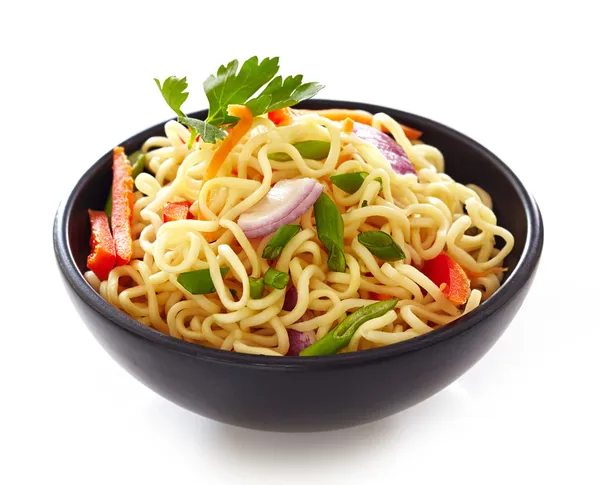Understanding Vermicelli: A Culinary Exploration
Vermicelli, often described as “tiny worms” due to its slender, worm-like appearance, is a traditional pasta originating from southern Italy. It comes in dried and fresh forms, with the dried version commonly made from semolina flour derived from durum wheat and eggs. The nutritional content of vermicelli includes 331 calories per 100 grams, with 82 grams of carbohydrates, 3.9 grams of dietary fiber, and minimal fats and proteins.
Types of Vermicelli: A Culinary Diversity
Vermicelli comes in various types, with Italian and Asian variants being the most prominent. Italian vermicelli, made from durum wheat flour, is thicker than spaghetti and can be used similarly to other pasta types. On the other hand, Asian vermicelli, also known as rice vermicelli, is made from rice flour and water. Other variations include cellophane noodles and glass noodles made from mung beans, Mexican fideos, and Indian falooda sev.
Decoding the Glycemic Index: A Crucial Aspect for Diabetics
For individuals with diabetes, understanding the Glycemic Index (GI) of foods is essential. Vermicelli, being a carbohydrate-rich food, has varying GI values depending on its source. Sweet potato vermicelli, with a GI of 34.5, falls into the low-GI category, making it a suitable option for those managing diabetes. However, it’s crucial to consider both the GI and Glycemic Load (GL) when assessing the impact on blood glucose levels.
Is Vermicelli Diabetes-Friendly?
There is a debate surrounding whether vermicelli is suitable for individuals with diabetes. Some argue that it may lead to blood sugar spikes, while others claim it has a low glycemic level and minimal impact. Vermicelli noodles, being a high-energy carbohydrate with low fat and cholesterol content, take longer to digest, preventing rapid spikes in blood sugar levels.
A 2-ounce portion of vermicelli contains 214 calories. While individuals with diabetes can enjoy vermicelli in moderation, it’s crucial to note that it is not a low-GI food that can be consumed in large quantities. Overconsumption can lead to elevated blood sugar levels, emphasizing the importance of portion control.
Choosing the Right Vermicelli for Diabetics
When selecting vermicelli for a diabetic-friendly diet, it’s essential to consider the glycemic index of different types. Rice vermicelli, with a glycemic load of 58, falls into the medium-GI category. In contrast, whole-wheat vermicelli boasts a lower glycemic index of 35, making it a preferable option for individuals with diabetes. Adding vegetables, spices, and limiting oil when preparing vermicelli dishes enhances their nutritional value and makes them a healthier choice.
When Vermicelli Might be Risky for Diabetics
For individuals with type 2 diabetes, it’s crucial to avoid foods with a high glycemic index. Raw rice vermicelli, with a glycemic index of 58, exceeds the recommended limit for diabetic-friendly foods. The simple carbohydrates in rice vermicelli are quickly absorbed into the bloodstream, leading to rapid spikes in blood sugar levels. Opting for complex carbohydrates over simple carbohydrates is advisable for individuals with diabetes.
The Role of Glycemic Load in Vermicelli Consumption
Understanding the Glycemic Load (GL) of vermicelli is equally important for individuals with diabetes. The GL considers both the quantity of carbohydrates in a serving and the food’s impact on blood glucose levels. While sweet potato vermicelli may have a high carbohydrate content, consuming smaller portions can result in a manageable GL, ensuring minimal impact on blood sugar levels.
Conclusion: A Balanced Perspective
In conclusion, vermicelli can be included in the diet of individuals with diabetes when consumed in moderation. Despite its high sugar content, the glycemic load can be manageable by controlling portion sizes. However, it’s essential to consider the glycemic index and glycemic load of different types of vermicelli, with a preference for whole-wheat options.
A diabetic diet requires careful monitoring, and individuals should prioritize foods with a low glycemic index to maintain stable blood sugar levels. While vermicelli can be a part of a diabetes-friendly diet, it should be balanced with other food groups like meat and vegetables. Whole-wheat vermicelli emerges as a more favorable option for diabetics, providing a lower glycemic index and additional nutritional benefits.
Healthier Vermicelli Preparations for Diabetics
Choosing healthier preparations of vermicelli can further enhance its suitability for individuals with diabetes. Vermicelli upma, a popular dish, can be made with whole-wheat vermicelli, adding vegetables and spices for flavor and nutrition. The glycemic load of whole-wheat vermicelli is lower, and the additional fiber from vegetables contributes to better blood sugar management.
In a 100-gram serving of vermicelli upma, the nutritional content includes 164.13 Kcal, 3.97 grams of protein, 5.04 grams of fat, and 25.03 grams of carbohydrates. The dish also provides essential vitamins and minerals, including Vitamin B2, Vitamin B6, Vitamin B9, Vitamin C, carotenoids, Vitamin D2, calcium, iron, and zinc.
Expert Recommendations and Considerations
While vermicelli can be a part of a diabetic-friendly diet, it’s essential to seek guidance from healthcare professionals and dietitians. Individual responses to different foods can vary, and personalized dietary plans are crucial for effective diabetes management. Monitoring blood sugar levels regularly and making adjustments to the diet based on these readings is integral to maintaining optimal health.
The Importance of Moderation and Knowledge
Incorporating vermicelli into a diabetic diet requires a balanced approach. Moderation is key, and understanding the nutritional content, glycemic index, and glycemic load of vermicelli types can empower individuals to make informed choices. Whole-wheat vermicelli stands out as a preferable option, offering a lower glycemic index and contributing to a more balanced and nutritious diet.
Final Thoughts
As we unravel the relationship between vermicelli and diabetes, it becomes evident that vermicelli can be part of a diabetic-friendly diet when consumed mindfully. The choice of vermicelli type, portion control, and preparation methods all play crucial roles in determining its impact on blood sugar levels. Whole-wheat vermicelli emerges as a healthier option, and incorporating it into balanced meals with vegetables and spices enhances its nutritional value.
In the journey of managing diabetes, knowledge is power. Understanding the intricacies of different foods, their effects on blood sugar, and making informed choices empower individuals to take control of their health. Vermicelli, when approached with moderation and awareness, can be a delightful addition to a well-managed and diverse diabetic diet.
Remember, the path to a healthy and balanced life with diabetes involves collaboration with healthcare professionals, regular monitoring, and a commitment to making informed and mindful choices in every culinary adventure.








